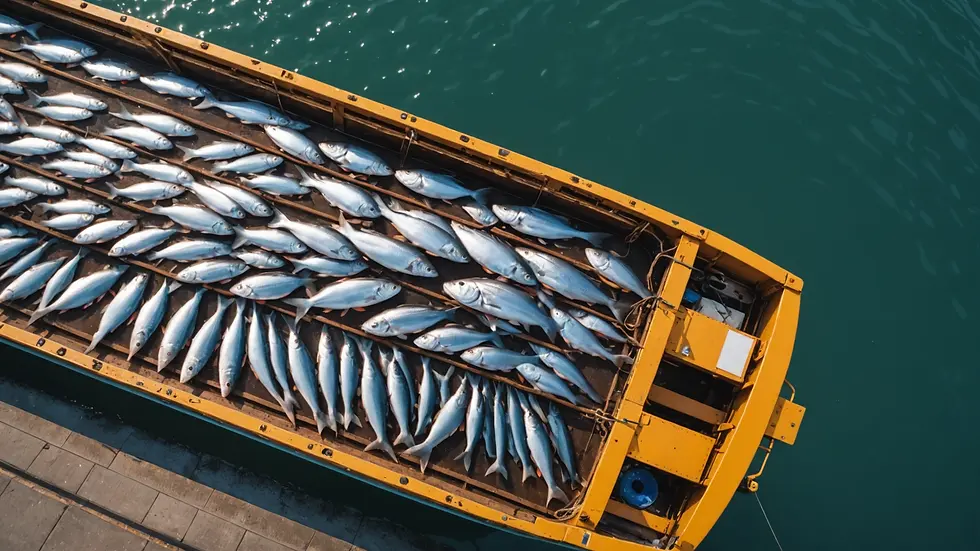Ensuring the Safe and Stress-Free Transportation of Your Fish: Expert Tips and Techniques
- Jyotiraj Borah
- Feb 5
- 5 min read
Transporting fish, whether for a personal aquarium or for sale at markets, requires careful planning and execution. The stress of relocation can greatly impact a fish's health. As responsible caretakers, it's essential that we ensure their safety and comfort during the journey. This guide will share best practices for transporting fish, minimizing stress and health risks effectively.
Understanding Fish Stress
Before considering transport methods, it’s vital to know what causes stress in fish. Stress arises from changes in environment, water quality, or temperature. Fish are sensitive creatures, and even minor changes can lead to serious health issues.
For example, research shows that stressed fish may experience up to a 50% drop in their immune response, making them more susceptible to diseases. Prolonged stress during transport can even lead to death, highlighting the importance of understanding stress triggers. Being mindful of these factors is crucial in planning a successful fish transport.
Preparing for Transport
Choosing the Right Container
Selecting an appropriate container for transport is one of the most critical steps. Here are key factors to consider:
Size: The container should be large enough for fish to swim comfortably, yet not so large that water management becomes a challenge. For example, a 10-gallon container works well for a few small fish, while larger fish may need more space.
Material: Use a leak-proof container made from non-toxic materials. Plastic bags are effective for short trips, while sturdy, rigid containers are better for longer journeys.
Air Supply: For extended trips, consider using containers with air supply systems. Fish need oxygen, especially when packed closely together. A portable battery-operated aerator can increase oxygen levels.
Insulation: If transporting over long distances or in fluctuating temperatures, use insulated containers to help maintain stable water conditions. Insulated containers can keep temperatures stable for several hours.
Preparing the Water
Water quality in the transport container significantly affects fish health. Here’s how to prepare:
Use Tank Water: Whenever possible, use water from the fish’s original tank. This helps maintain the correct pH, hardness, and temperature, making the transition smoother.
Add Stress Coating: Incorporate a water conditioner or stress coat to alleviate stress and protect fish from abrasions. Products with Aloe vera can help soothe fish skin.
Temperature Control: Ensure the water matches the tank’s temperature. If you’re unsure, use an aquarium thermometer to check. Maintaining temperature is crucial, as fish can become lethargic or stressed if temperatures shift significantly.
Aerate the Water: For large containers, aerate the water beforehand. Increasing oxygen levels is vital, especially for fish species known for their high oxygen demands, like goldfish.
Packing the Fish
Catching the Fish
To minimize stress, gently use a net to catch your fish instead of your hands. Being calm and steady during this process prevents startling them and reduces stress levels.
Filling the Container
Go Slow: Place the fish in the container slowly, avoiding splashing to keep them calm.
Limit Water: Fill the container with just enough water to cover the fish. Excess water can lead to increased movement and more stress. A good rule is to fill the container to about 60% capacity.
Add Oxygen: For longer trips, consider adding pure oxygen, especially if multiple fish share the container. Oxygen tablets can also be a great option for quick oxygenation.
Adding a Lid
For safety, cover the container with a lid or secure it with tape. This minimizes the chance of fish jumping out and reduces stress caused by flashes of light.
Transport Methods
Short-Distance Transportation
For short distances (under an hour), use bags filled with tank water. Aim to fill bags to about one-third capacity, seal them, and gently handle them during transport. Avoid vigorous shaking to prevent distress.

Long-Distance Transportation
For longer distances (over an hour), consider a harder container:
Water Changes: If transport lasts several hours, change a portion of the water halfway through to keep it clean. Fish create waste, and a cleaner environment maintains their well-being.
Air Pump: For extended travel times, an air pump can help oxygenate the water, ensuring fish remain healthy. Portable battery-operated pumps are a great investment.
Temperature Regulation: During transport, keep the container in a controlled environment, avoiding direct sunlight. Use blankets or insulated bags to buffer against temperature changes.
Shipping Fish
If shipping fish, always check the carrier’s specific regulations. Some companies specialize in aquatic transportation and provide guidelines for safe packaging.
Insulated Boxes: Utilize insulated boxes with appropriate padding to minimize shifts during transport.
Live Fish Labels: Clearly label the package to inform carriers about the live fish inside.
Preparation: Ship fish early in the week to avoid delays. This ensures they do not remain in transit over weekends, which can lead to stress and mortality.
Monitoring Your Fish During Transport
Check on Them Frequently
If transporting fish yourself, make frequent stops to monitor their condition. Look for distress signs such as gasping at the surface or erratic swimming.
Maintaining Environment
Adjust environmental conditions as needed. If temperatures fluctuate outside the desired range, take action to maintain a livable habitat for the journey.
Bring Supplies
Having essential supplies on hand, such as a thermometer, test kits, and extra bags, can help address emergencies during transport. Being prepared ensures a smoother experience.
After Transport
Acclimating Fish to New Environment
Once you arrive at your destination, acclimate the fish properly:
Float the Bag: If fish are in bags, float the sealed bags on the surface of the new tank for about 15 minutes to help equalize temperature.
Gradual Integration: Slowly add tank water to the bags over 15-30 minutes before finally releasing the fish into their new home. This gradual method reduces stress during the transition.
Monitoring Health
After introducing the fish to the new tank, closely monitor them for several days. Look for signs of stress or illness, such as lack of appetite or unusual swimming behavior. Prompt action can prevent further health issues.
Final Thoughts
Transportation can be a stressful experience for fish, but proper planning and care make it safe and effective. By choosing the right containers, preparing the water well, and following best practices throughout the process, owners can ensure their aquatic pets arrive healthy and happy at their destination.
Always remember to minimize disruption to your fish's environment during transport. With these techniques, you can enjoy a stress-free transfer for your aquatic friends, allowing them to settle quickly into their new surroundings.
Fish transportation does not have to be overwhelming. With knowledge and preparation, you can ensure their comfort and well-being, making the experience smoother for both you and your fish.






Commentaires